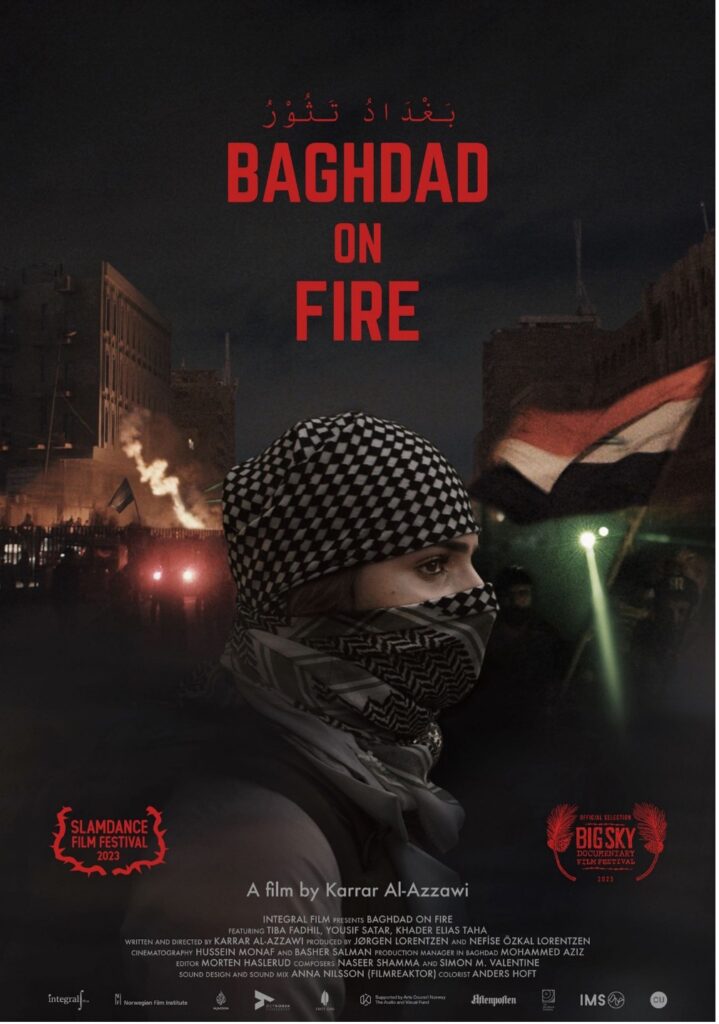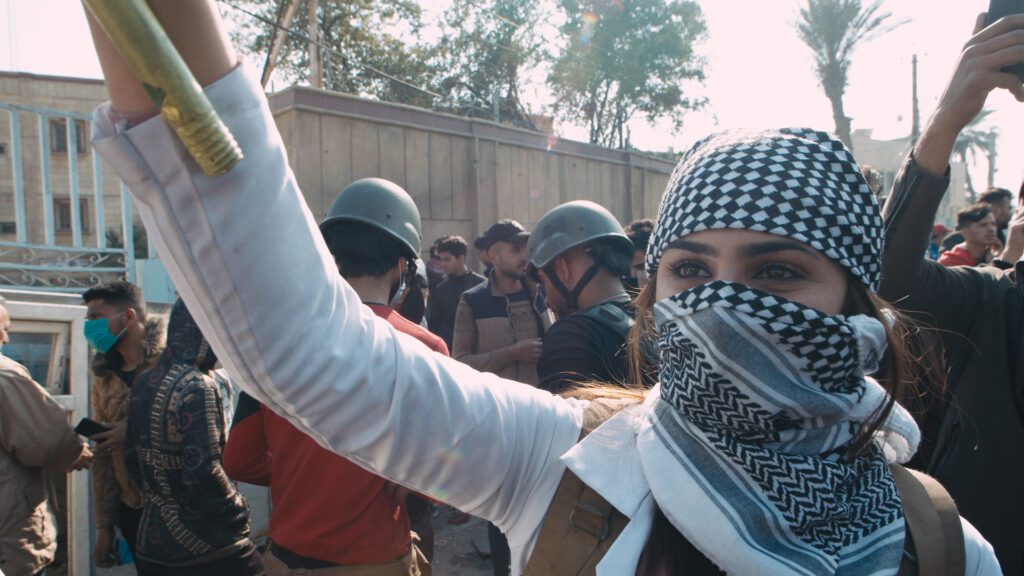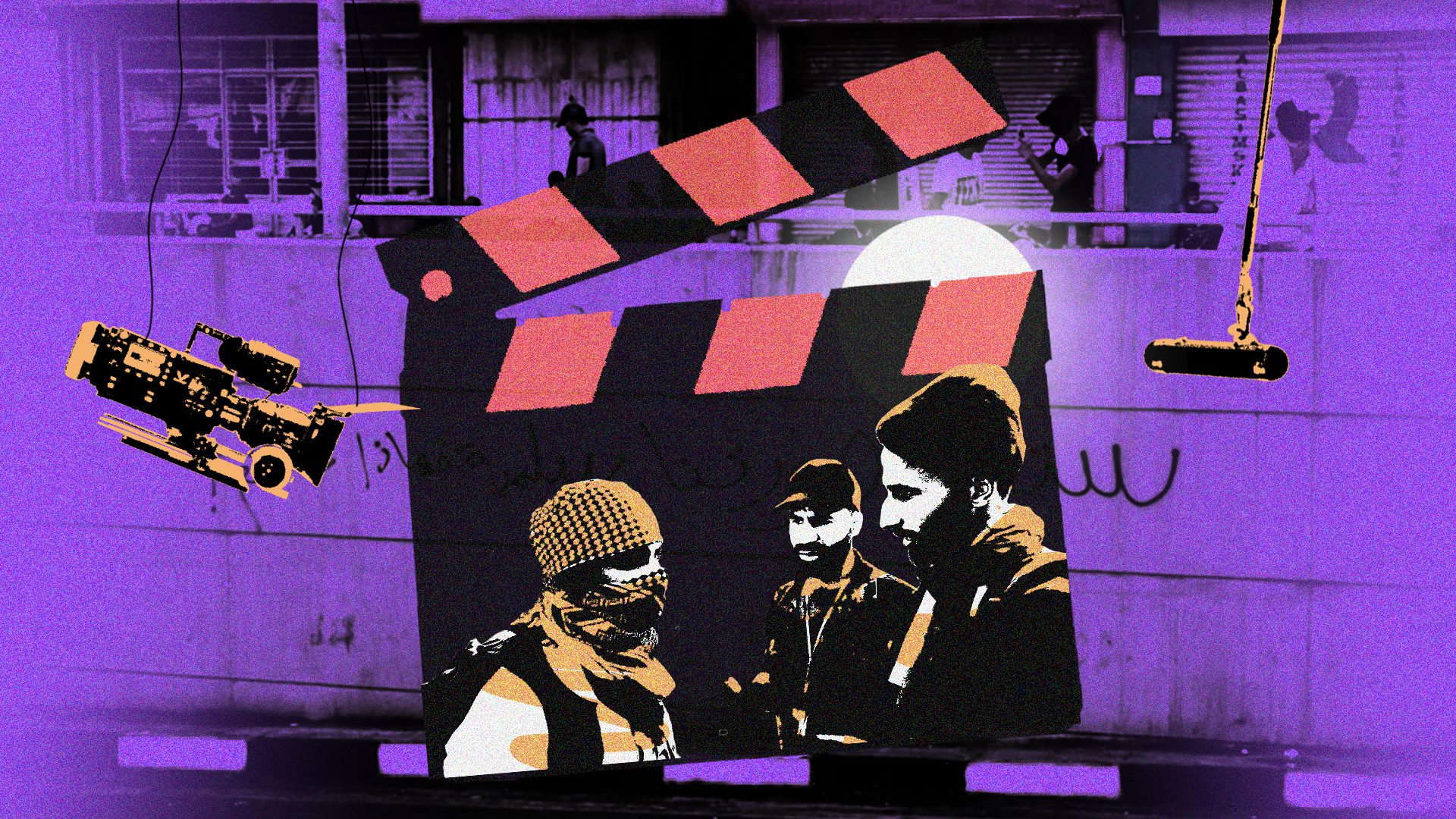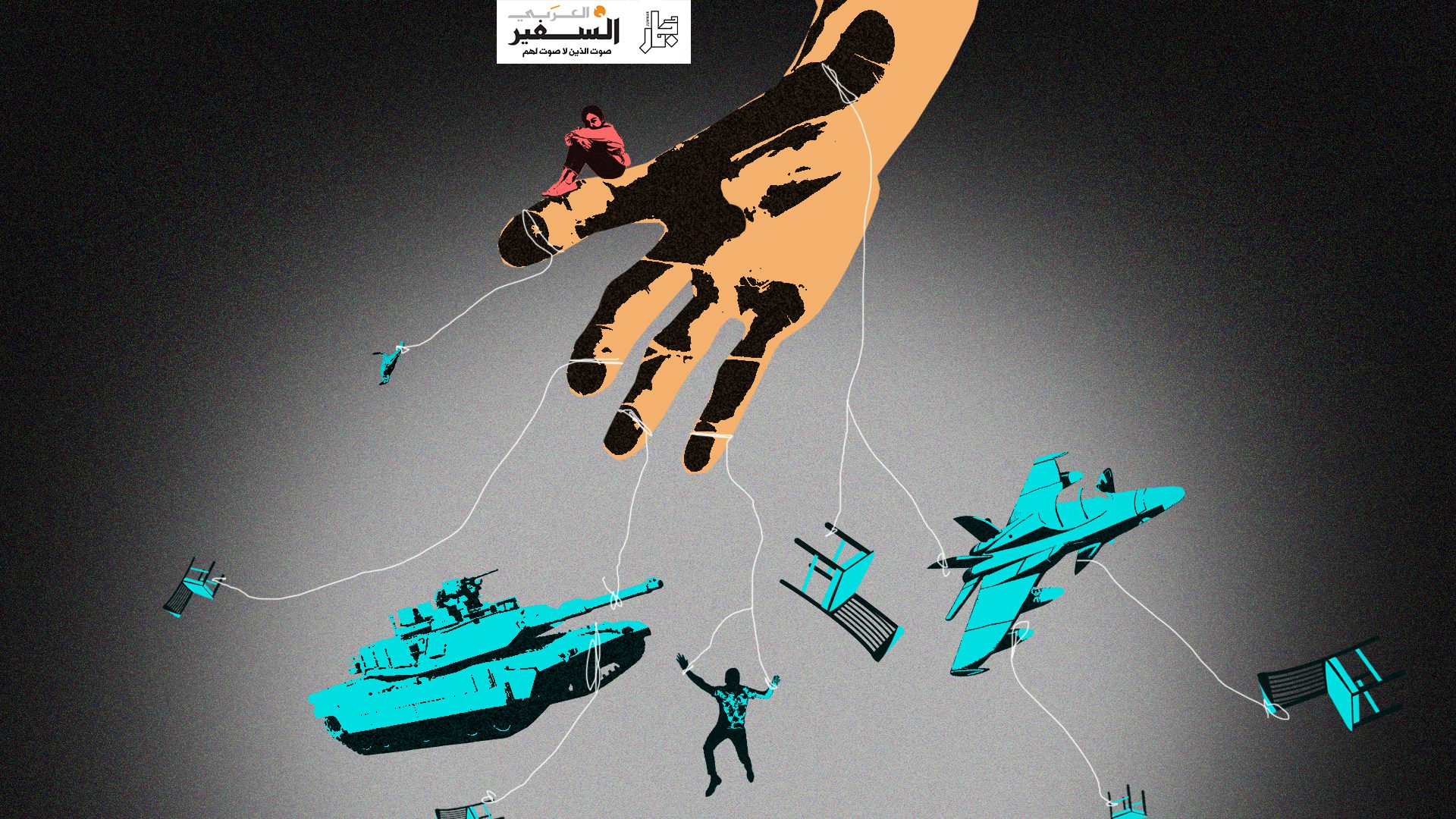‘Baghdad on Fire’: Third Spaces, Trauma & Triumph from Tahrir
02 May 2023
Baghdad on Fire is a film narrating stories from the Tishreen Revolution, the biggest political and social event in the modern history of Iraq, through the eyes of Tiba and her fellow activists.
The opening scene of Baghdad on Fire (2023) begins with young protestors passionately responding “NO” to a series of questions: Are you American? Are you Iranian? Are you Shi’a? Are you Sunni? When asked “Are you Iraqi,” the group shouts with delight “YES!” This scene sets the stage for the collective and non-denominational vision at the heart of the Tishreen Revolution, which began in Iraq in October 2019. The film is narrated through the eyes and aspirations of Tiba – a 19-year-old medic and revolutionary – who survives an abusive marriage to discover an Iraq she could only dream of through the solidarities she builds in the protest camps of Tishreen, where strangers become kin overnight.
In the film, Tiba along with fellow activists Yousif and Khader are leading a medical team to treat protestors attacked by tear gas. The film’s director Karrar al-Azzawi intentionally focused the narrative on Tiba as the central protagonist in order to counter the abstract (and often dehumanizing) ways that protesters during Tishreen were represented in the media both inside and outside of Iraq. When asked repeatedly what they want and why they won’t go home, Tiba replies simply that they want their country (“Enrid Watan” – We want a Country”) so that they can rebuild it in the image of the world they created in Tahrir. Al-Azzawi is no stranger to this sentiment, as he too has been a long-time political organizer who was compelled to leave the country in 2016 and settle in Norway.
To defy dominant narratives, al-Azzawi’s choice to embark on the challenging and dangerous task of producing a feature-length documentary film during a revolution where hundreds of protesters were killed, and thousands injured, was not taken lightly. However, al-Azzawi’s team, including the cinematographer Hussein Monaf, production manager Mohammed Aziz, along with countless others who worked behind and in front of the camera, chose to participate in this creative endeavor because they knew that their stories would never get told otherwise. Despite the sometimes-frenetic movement of the camera that signaled urgency, al-Azzawi directed his team to try and always keep Tiba in the frame. It was crucial for the audience to be with her so that viewers could empathize with her through moments of elation, defiance, and despair that thousands of young people like her experienced. Moreover, the film’s focus on the lives of a few individuals helps the audience understand the complex trajectories that led each organizer to Tahrir despite the consequences.

Al-Azzawi remarked that, if you asked anyone who participated in Tishreen what the best days of their lives were, they would respond that the best days they lived were during the revolution. Perhaps that’s what is complicated about this film, which at once confronts the viewer with the trauma, injury, and death caused during Tishreen, while also revealing the sheer strength, resilience, and imagination of its participants who believe that the revolution continues. The loss, for instance, is embodied in the tragic death of one of the protagonists Yousif Satar to whom the film is dedicated. However, the promise and potential of Tishreen lives on in the memory of the third space that protesters created through the barricades, occupied bridges, public squares, murals, and communal food, transport, educational, entertainment, electricity, and medical infrastructures. While the protesters’ criticisms of the ruling regime were targeted towards a lack of jobs, food, security, basic infrastructure, ethical governance, and accountability. Baghdad on Fire offers the audience a momentary glimpse into a society marked by abundance where non-hierarchical cooperation, compassion, and redistribution of food, tents, blankets, and medicine ensure that no one goes to bed feeling sick, cold, hungry, or alienated at night.
These glimpses, however, are not particular to Tishreen alone. For example, during the 2020-2021 Farmer’s Protest movement in India, tens of thousands of farmers camped out in New Delhi at the Tikri, Singhu, and Ghazipur borders, along with the Red Fort. These protests camps had set up temporary cities replete with clinics, libraries, kitchens, and makeshift town halls. As in Tahrir, where al-Azzawi’s film shows how many of the young protesters felt for the first time that they were Iraqi, the lively debates and discussion forums in the farmer’s camps were sites where similar trans-regional solidarities and understanding of farmers’ economic conditions in this New India were being theorized. From Tahrir square in Cairo, Martyr’s square in Beirut, Zuccotti Park in New York City to Tahrir square in Baghdad, protest camps created spaces of experimentation for self-organization and egalitarian social relations that rejected existing governmental institutions and political parties. And yet, the narrative around the end of these encampments often falls prey to short-termism and bleak outlooks: The revolution cannot work. The youth do not have a plan. They need to grow up and come back to the real world. Things will never change.


Premiering on March 20, 2023 – three years after Tishreen and twenty years after the U.S.-led occupation of Iraq – Baghdad on Fire tries to dispel these superficial narratives of failure and instead focuses on the revolutions of the mind. When Tiba dares to exclaim that the revolution has no leader and rejects co-optation of protesters’ demands by existing political factions, she defies hundreds of years of attempts at hierarchical, top-down governance over the provinces that constitute modern Iraq. Even through small gestures when fellow protesters try to insinuate that she cannot carry a few blankets by herself, she is quick to challenge gendered norms by asking why they are enacting hierarchy (tabaqiyat). The film’s focus on these seemingly minor exchanges reveals how self-organization continuously demands both self-reflection and mutual accountability.
Another powerful scene takes place within a tent where an older generation of activists speak with Tiba and her friends. An older man remarks that his generation began to follow the maxim might is right, giving in to the power of military and religious leaders alike. But Tiba explains that her generation grew up with military occupation, bombs, and kidnappings, so they have nothing to lose and nothing to fear. Perhaps this generation has more in common with the youth who came of age in the 1940s and 1950s who too felt they had nothing to lose. What further connects those past movements with present ones is the violent manner in which they were suppressed by openly firing on crowds and targeted arrests or assassinations of key political organizers. When police open fired on protesting railway workers, college students, and rural migrants on 20 January 1948, people responded by building makeshift memorials to honor the lives lost across Baghdad. Baghdad on Fire also showcases these tender, collective moments of mourning for each life lost.
Despite these traumas, the film concludes on a hopeful note and reminds viewers to focus their eyes on the distant horizon. Like the students who marched with rural migrants during the 1948 al-Watbah and those who marched in the 1952 Intifada against yet another renewal of the Anglo-Iraqi treaty which prioritized foreign interests, Tishreen continues the twentieth-century legacy of mass protest movements that were responding to multi-generational cycles of dispossession, political strife, and foreign interference. Each cycle of mass protests in the past has brought hard-won social and economic gains for Iraq’s population from educational reforms and employment to housing and land redistribution. Al-Azzawi asked the film’s cinematographers to focus on long shots, so the camera never stops moving. The seemingly endless movement of the camera almost echoes the endless momentum of Iraq’s political movements past and present, despite their ebbs and flows. Considering this long view of history, Tishreen could be seen as a brief period of rapture, or an eternal memory captured both in film and the minds of those who have witnessed the promise of an other Iraq.
Baghdad on Fire premiered at the CPH:DOX Film Festival in Copenhagen, Denmark on March 20, 2023. For more information, see: https://cphdox.dk/film/baghdad-on-fire/
Further Reading
Zahra Ali, “Theorising uprisings: Iraq’s Thawra Teshreen,” Third World Quarterly, 2023, https://doi.org/10.1080/01436597.2022.2161359
Huma Gupta, Migrant Sarifa Settlements and State-Building in Iraq, Ph.D. diss., MIT, 2020, https://dspace.mit.edu/handle/1721.1/138589
Raheem Mahmood, “When Authorities were Confronted with the Tishreen youth uprising… they were legalising killing to maintain order,” Jummar Media, 2 October 2022, https://jummar.media/en/1787
Read More
The opening scene of Baghdad on Fire (2023) begins with young protestors passionately responding “NO” to a series of questions: Are you American? Are you Iranian? Are you Shi’a? Are you Sunni? When asked “Are you Iraqi,” the group shouts with delight “YES!” This scene sets the stage for the collective and non-denominational vision at the heart of the Tishreen Revolution, which began in Iraq in October 2019. The film is narrated through the eyes and aspirations of Tiba – a 19-year-old medic and revolutionary – who survives an abusive marriage to discover an Iraq she could only dream of through the solidarities she builds in the protest camps of Tishreen, where strangers become kin overnight.
In the film, Tiba along with fellow activists Yousif and Khader are leading a medical team to treat protestors attacked by tear gas. The film’s director Karrar al-Azzawi intentionally focused the narrative on Tiba as the central protagonist in order to counter the abstract (and often dehumanizing) ways that protesters during Tishreen were represented in the media both inside and outside of Iraq. When asked repeatedly what they want and why they won’t go home, Tiba replies simply that they want their country (“Enrid Watan” – We want a Country”) so that they can rebuild it in the image of the world they created in Tahrir. Al-Azzawi is no stranger to this sentiment, as he too has been a long-time political organizer who was compelled to leave the country in 2016 and settle in Norway.
To defy dominant narratives, al-Azzawi’s choice to embark on the challenging and dangerous task of producing a feature-length documentary film during a revolution where hundreds of protesters were killed, and thousands injured, was not taken lightly. However, al-Azzawi’s team, including the cinematographer Hussein Monaf, production manager Mohammed Aziz, along with countless others who worked behind and in front of the camera, chose to participate in this creative endeavor because they knew that their stories would never get told otherwise. Despite the sometimes-frenetic movement of the camera that signaled urgency, al-Azzawi directed his team to try and always keep Tiba in the frame. It was crucial for the audience to be with her so that viewers could empathize with her through moments of elation, defiance, and despair that thousands of young people like her experienced. Moreover, the film’s focus on the lives of a few individuals helps the audience understand the complex trajectories that led each organizer to Tahrir despite the consequences.



Al-Azzawi remarked that, if you asked anyone who participated in Tishreen what the best days of their lives were, they would respond that the best days they lived were during the revolution. Perhaps that’s what is complicated about this film, which at once confronts the viewer with the trauma, injury, and death caused during Tishreen, while also revealing the sheer strength, resilience, and imagination of its participants who believe that the revolution continues. The loss, for instance, is embodied in the tragic death of one of the protagonists Yousif Satar to whom the film is dedicated. However, the promise and potential of Tishreen lives on in the memory of the third space that protesters created through the barricades, occupied bridges, public squares, murals, and communal food, transport, educational, entertainment, electricity, and medical infrastructures. While the protesters’ criticisms of the ruling regime were targeted towards a lack of jobs, food, security, basic infrastructure, ethical governance, and accountability. Baghdad on Fire offers the audience a momentary glimpse into a society marked by abundance where non-hierarchical cooperation, compassion, and redistribution of food, tents, blankets, and medicine ensure that no one goes to bed feeling sick, cold, hungry, or alienated at night.
These glimpses, however, are not particular to Tishreen alone. For example, during the 2020-2021 Farmer’s Protest movement in India, tens of thousands of farmers camped out in New Delhi at the Tikri, Singhu, and Ghazipur borders, along with the Red Fort. These protests camps had set up temporary cities replete with clinics, libraries, kitchens, and makeshift town halls. As in Tahrir, where al-Azzawi’s film shows how many of the young protesters felt for the first time that they were Iraqi, the lively debates and discussion forums in the farmer’s camps were sites where similar trans-regional solidarities and understanding of farmers’ economic conditions in this New India were being theorized. From Tahrir square in Cairo, Martyr’s square in Beirut, Zuccotti Park in New York City to Tahrir square in Baghdad, protest camps created spaces of experimentation for self-organization and egalitarian social relations that rejected existing governmental institutions and political parties. And yet, the narrative around the end of these encampments often falls prey to short-termism and bleak outlooks: The revolution cannot work. The youth do not have a plan. They need to grow up and come back to the real world. Things will never change.

Premiering on March 20, 2023 – three years after Tishreen and twenty years after the U.S.-led occupation of Iraq – Baghdad on Fire tries to dispel these superficial narratives of failure and instead focuses on the revolutions of the mind. When Tiba dares to exclaim that the revolution has no leader and rejects co-optation of protesters’ demands by existing political factions, she defies hundreds of years of attempts at hierarchical, top-down governance over the provinces that constitute modern Iraq. Even through small gestures when fellow protesters try to insinuate that she cannot carry a few blankets by herself, she is quick to challenge gendered norms by asking why they are enacting hierarchy (tabaqiyat). The film’s focus on these seemingly minor exchanges reveals how self-organization continuously demands both self-reflection and mutual accountability.
Another powerful scene takes place within a tent where an older generation of activists speak with Tiba and her friends. An older man remarks that his generation began to follow the maxim might is right, giving in to the power of military and religious leaders alike. But Tiba explains that her generation grew up with military occupation, bombs, and kidnappings, so they have nothing to lose and nothing to fear. Perhaps this generation has more in common with the youth who came of age in the 1940s and 1950s who too felt they had nothing to lose. What further connects those past movements with present ones is the violent manner in which they were suppressed by openly firing on crowds and targeted arrests or assassinations of key political organizers. When police open fired on protesting railway workers, college students, and rural migrants on 20 January 1948, people responded by building makeshift memorials to honor the lives lost across Baghdad. Baghdad on Fire also showcases these tender, collective moments of mourning for each life lost.
Despite these traumas, the film concludes on a hopeful note and reminds viewers to focus their eyes on the distant horizon. Like the students who marched with rural migrants during the 1948 al-Watbah and those who marched in the 1952 Intifada against yet another renewal of the Anglo-Iraqi treaty which prioritized foreign interests, Tishreen continues the twentieth-century legacy of mass protest movements that were responding to multi-generational cycles of dispossession, political strife, and foreign interference. Each cycle of mass protests in the past has brought hard-won social and economic gains for Iraq’s population from educational reforms and employment to housing and land redistribution. Al-Azzawi asked the film’s cinematographers to focus on long shots, so the camera never stops moving. The seemingly endless movement of the camera almost echoes the endless momentum of Iraq’s political movements past and present, despite their ebbs and flows. Considering this long view of history, Tishreen could be seen as a brief period of rapture, or an eternal memory captured both in film and the minds of those who have witnessed the promise of an other Iraq.
Baghdad on Fire premiered at the CPH:DOX Film Festival in Copenhagen, Denmark on March 20, 2023. For more information, see: https://cphdox.dk/film/baghdad-on-fire/
Further Reading
Zahra Ali, “Theorising uprisings: Iraq’s Thawra Teshreen,” Third World Quarterly, 2023, https://doi.org/10.1080/01436597.2022.2161359
Huma Gupta, Migrant Sarifa Settlements and State-Building in Iraq, Ph.D. diss., MIT, 2020, https://dspace.mit.edu/handle/1721.1/138589
Raheem Mahmood, “When Authorities were Confronted with the Tishreen youth uprising… they were legalising killing to maintain order,” Jummar Media, 2 October 2022, https://jummar.media/en/1787









